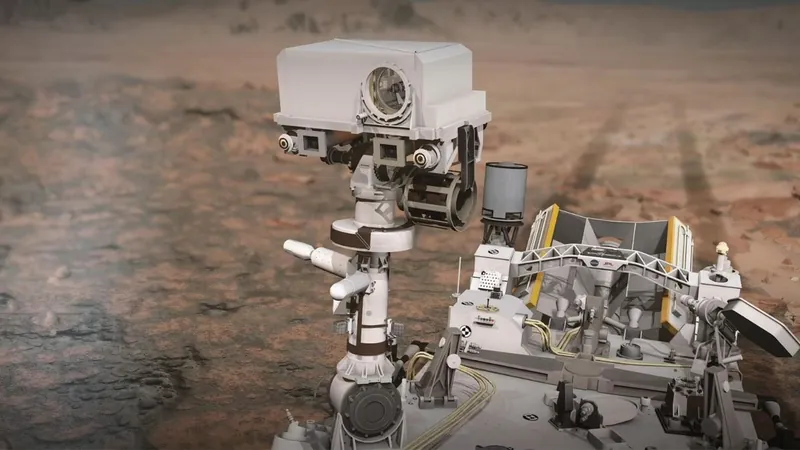
NASA's Perseverance Rover: A Close Encounter with Martian Organics—But Wait, There's More!
2024-11-20
Author: Mei
The drive to uncover life beyond Earth has fascinated humanity for ages, fueling missions that reach farther into our solar system than ever before. Last summer, NASA’s Perseverance rover made headlines with a tantalizing discovery on Mars, identifying potential carbon-based molecules, known as organics, which some scientists speculate might hint at the existence of ancient extraterrestrial life.
This exciting finding has sparked a flurry of discussions and debates within the scientific community, inching us closer to answering the profound question of whether life ever existed—or could still exist—on the Red Planet.
However, a layer of uncertainty surrounds these discoveries; scientists caution that the signals detected may not definitively indicate organic molecules. While many believe the possibility is strong, other explanations remain viable. This uncertainty arises partly from the limitations of the rover's instruments, which, despite their avant-garde design, do not fully replicate the capabilities of Earth-based laboratories.
The SHERLOC (Scanning Habitable Environments with Raman and Luminescence for Organics and Chemicals) instrument onboard Perseverance was key to this finding. "The SHERLOC instrument is our premier tool for detecting organic matter," explained Ken Farley, project scientist for the mission. "It is the only instrument we think has a reasonable chance of finding organic matter at the likely concentrations."
SHERLOC utilizes two main techniques: deep ultraviolet luminescence and Raman spectrometry. The luminescence mode generates substantial signals from specific organic molecules, but it is not uniquely diagnostic. Many substances, organic or otherwise, can emit light when energized, which creates ambiguity in identifying their origin.
On the other hand, Raman spectroscopy, a common tool in chemistry, offers a more precise "fingerprint" of molecular structures despite being less sensitive. “There are patterns of peaks in a Raman spectrum, and you can relate them to specific types of organic molecules,” Farley added.
The geological backdrop for this mission is Jezero Crater, an area once thought to have hosted an ancient lake around 3.5 billion years ago—similar to environments on Earth that are indicative of ancient microbial life. In its quest, Perseverance detected luminescence signals that initially suggested the presence of diverse organic compounds on Mars.
However, subsequent studies have proposed alternative interpretations, notably a paper indicating that the detected signals might instead result from inorganic materials like cesium ions found in ancient geological formations. "Multiple chemicals can give rise to these same spectral features," cautioned Eva Scheller, a planetary scientist at MIT involved in the research. This phenomenon, known as degeneracy, complicates the interpretation of spectral data and poses significant challenges.
While the original Nature paper indicated a likelihood of aromatic organics, both Farley and Scheller emphasize that the presence of such molecules does not equate to biological origins. "Even if we detect aromatic organics, it doesn’t necessarily indicate life," noted Scheller.
NASA's ongoing sample-return proposal aims to resolve these uncertainties further. Such missions would allow more detailed analyses back on Earth, where sophisticated and high-resolution laboratory techniques could distinguish between abiotic and biological origins of organic compounds.
The complexities of Martian research won’t prevent the Perseverance team from pushing ahead; rigorous analysis and correction are part of scientific progress. Farley remarked on the necessity of remaining open to alternative theories. "Science corrects itself, and that's a fundamental part of our understanding," he said.
So, as we stand on the brink of potentially redefining life in the universe, questions and debates will continue to flourish. Is Mars the next great frontier for biology? Only time—and further research—will tell. Stay tuned as we uncover the secrets of the cosmos!



 Brasil (PT)
Brasil (PT)
 Canada (EN)
Canada (EN)
 Chile (ES)
Chile (ES)
 España (ES)
España (ES)
 France (FR)
France (FR)
 Hong Kong (EN)
Hong Kong (EN)
 Italia (IT)
Italia (IT)
 日本 (JA)
日本 (JA)
 Magyarország (HU)
Magyarország (HU)
 Norge (NO)
Norge (NO)
 Polska (PL)
Polska (PL)
 Schweiz (DE)
Schweiz (DE)
 Singapore (EN)
Singapore (EN)
 Sverige (SV)
Sverige (SV)
 Suomi (FI)
Suomi (FI)
 Türkiye (TR)
Türkiye (TR)